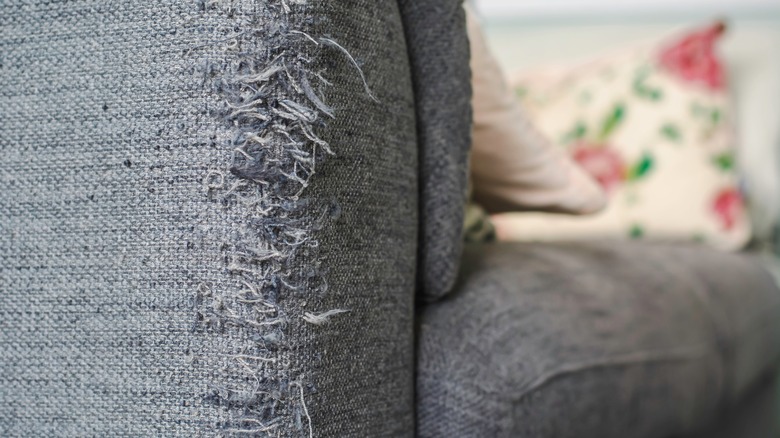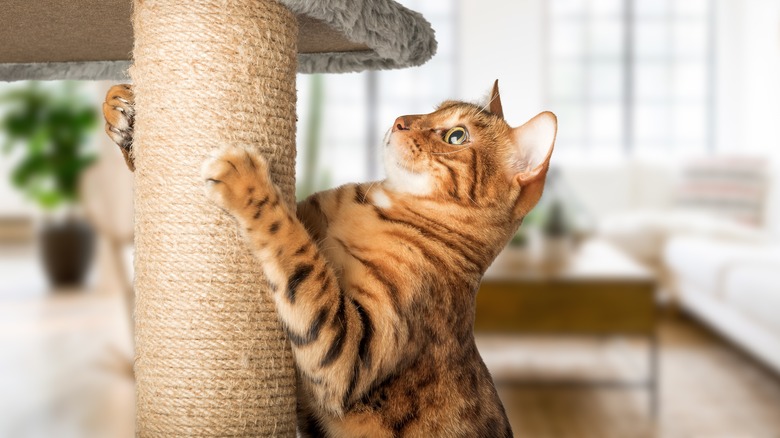Aluminum Foil Might Save Your Furniture From Pet Claws
Pets are an important part of our families, but they pose a challenge for our furniture thanks to their claws. There is nothing worse than splurging on an expensive couch or finding a unique ottoman, only to find your cat using it as a scratching post or your messy dog laying clear across the white cushions. If you want to deter your pets from scratching or climbing all over your furniture, then aluminum foil might be able to help. People have found anecdotal success using the kitchen staple to deter their pets from touching certain pieces. There are two ways you can go about using this hack.
The first is to deter cats from scratching. Simply wrap the area they like to scratch with a large swatch of aluminum foil, and that should stop them from sinking their claws into the fabric. The hope is that after leaving the aluminum foil on for a few weeks, they will learn that they shouldn't be scratching that item. The second hack is for dogs who jump onto furniture you don't want them on, such as a white couch. All you need to do is place a long sheet of aluminum foil across the seats, which will repel them from cozying up on there. Here is why this aluminum foil hack has worked for so many people, and any caveats to keep in mind when trying it with your own furry pals.
Why pets are deterred by aluminum foil
Pets dislike aluminum foil because it's weird, uncomfortable, and unsatisfying to tear up or lay on. "Dogs don't like very unorthodox things," celebrity dog trainer Brandon McMillan told The Rachael Ray Show. "The second her paws hit [the aluminum foil], it's going to make [a] noise, and she gets off right away." Similarly, trusted veterinarian practices state that aluminum foil can deter cats because both the texture and sound are unpleasant to these animals. They won't like the slick feel under their paws or the scary, crinkly sound it makes when it's touched, so it will likely stop them from scratching that area.
Another reason is that scratching that material isn't satisfying. Cats tend to gravitate towards rougher fabrics like sisal or cardboard to scratch, so when you have something smooth and glossy, it doesn't provide the same satisfaction. This will eventually deter them from attacking that particular piece and move on to somewhere else. No matter which animal you have in your house, this is a great way to protect your furniture without causing harm to your pets.
Caveats to keep in mind
Remember — not all pets are created the same. That means what might work for one might be completely ineffective for another. Since aluminum foil is easily accessible and affordable, it's a hack worth trying. Just keep in mind it's not guaranteed to work on each and every animal since each pet has unique preferences and fears. Secondly, the effect of this hack can also wear off after some time. While your dog might have been afraid of the tin's crinkling at first, he might eventually learn it doesn't pose a risk and jump on top of it, ignoring it.
In moments like those, your best bet is to redirect them. The most important thing to understand about your pets is that they don't understand the difference between being naughty and good. They only understand their urges and what to do to meet them. So when they scratch your couch or jump on the pristine white ottoman, they're only thinking that they need to shorten their claws or find a comfy spot to relax. So, if the foil hack doesn't work, your next best bet is to help them meet their needs in a way that you approve. For cats, that would be providing them with a sturdy scratching post. Position the post next to the furniture they like to scratch, providing them with an approved option. For dogs, that can be an elevated dog bed next to the couch.

